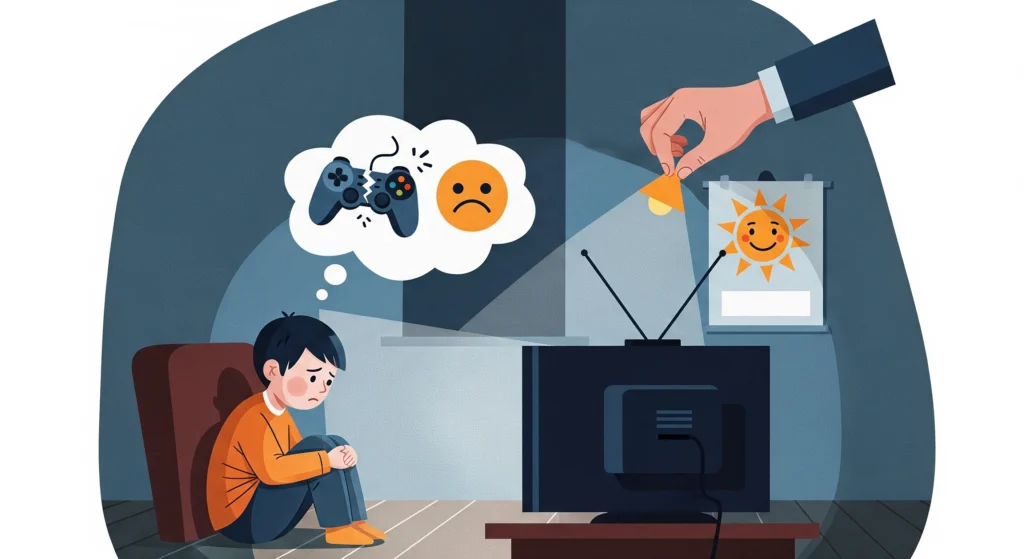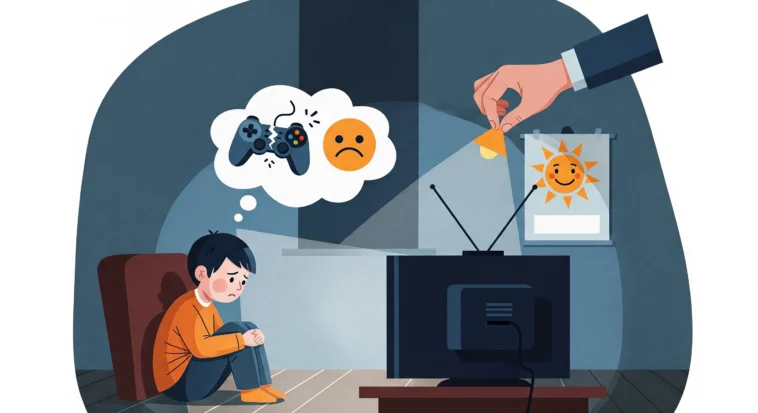
Have you noticed how taking away a favorite toy often works better than scolding? That’s negative punishment in action — not adding pain, but removing something you like to change behavior.
Despite the scary name, it’s not about being mean.
It’s actually a smart, science-backed way to help people learn. Parents, teachers, even managers use it.
And when done right, it can create real, lasting change — like teaching lessons that stick without the yelling.
What Is Negative Punishment in Psychology?
Negative punishment comes from B.F. Skinner’s famous operant conditioning theory.
It’s not about being mean — “negative” just means taking something away.
Basically, if someone does something unwanted, you remove something they enjoy so they’re less likely to repeat it.
Think losing phone time right after breaking a rule.
Key Components of Negative Punishment
- Timing: Do it right after the behavior (like taking away the controller the moment your sibling won’t stop yelling).
- Consistency: Every time the behavior happens, the consequence happens.
- Proportionality: The “loss” should fit the behavior — grounding for a week isn’t fair for forgetting homework once.
- Clarity: The person needs to get why the privilege was removed, or it just feels random.
How Negative Punishment Differs from Other Behavioral Techniques
If you really want to understand negative punishment, you’ve got to see how it stacks up against the other big players in behavior psychology.
Let’s break it down with some real-life examples.
Negative Punishment vs Positive Punishment
Negative punishment is all about taking away something you like, while positive punishment is about adding something you don’t like.
Imagine your mom takes away your PlayStation because you stayed up too late gaming — that’s negative punishment.
Now imagine instead she makes you scrub the bathroom as a consequence — that’s positive punishment.
One removes fun, the other adds “ugh.”
Negative Punishment vs Negative Reinforcement
This is where most people get tripped up.
Negative reinforcement doesn’t punish you at all — it actually rewards good behavior by taking away something annoying.
Think about this: your parents stop nagging once you finally clean your room. That’s negative reinforcement — you do the thing, and the nagging disappears.
Negative punishment, on the other hand, is when your parents take away TV time because you didn’t clean your room.
One removes stress, the other removes fun. Big difference.
Negative Punishment vs Extinction
Extinction is like ghosting a behavior. You don’t reward it, you don’t punish it — you just stop giving it attention until it fizzles out.
For example, if your little brother keeps making dumb jokes to get a laugh and everyone just ignores him, eventually he’ll stop.
Negative punishment, though, is more direct — it’s “You lost your toy because you threw it at the wall.” One is silence, the other is “nope, that’s gone.”
The Psychology Behind Negative Punishment Effectiveness
Operant Conditioning Principles
Okay, here’s the science-y part made simple: negative punishment works because of operant conditioning — basically, our brains are wired to connect actions with outcomes.
If every time you throw your homework in the trash you lose your phone for the night, your brain eventually goes, “Hmm… maybe not worth it.”
It’s like teaching your brain to see the pattern and avoid the pain of losing something you value.
Emotional and Cognitive Impact
Yeah, losing stuff you love can sting. Sometimes it even feels unfair.
But when it’s done right (not extreme, not random), it actually teaches you powerful life skills:
- You become more aware of what your choices lead to — like connecting the dots.
- You start thinking twice before acting — “If I do this, what will happen?”
- You learn self-control, not because someone’s watching, but because you know better.
- You see how actions really do have consequences, which is kind of the rulebook for adulting.
Neurobiological Mechanisms
Here’s the cool brain science: when you lose something you care about, parts of your brain light up — especially the anterior cingulate cortex and prefrontal cortex (fancy names, I know).
Decision-making and the emotional impact of loss are integral to these areas.
Essentially, the brain has a greater disdain for losing than for attaining gain.
If a bad habit is linked to losing something you like, your brain adapts to avoid making the same mistake.
Best Practices for Implementing Negative Punishment
1. Establish Clear Expectations
Here’s the deal — people can’t follow rules they don’t understand.
Before using negative punishment, make it crystal clear:
- What’s not okay (like hitting your sibling or blowing off homework).
- What you might lose (phone, gaming time, hanging out with friends).
- Why those two things are connected.
2. Ensure Immediate Implementation
Timing is everything. If you mess up at lunch but don’t lose your phone until bedtime, your brain doesn’t connect the dots.
But if your phone is gone right after the behavior, your brain goes: “Oh… THAT’s why.”
3. Maintain Consistency
Nothing kills the lesson faster than mixed signals.
If you lose gaming time for smacking your brother on Monday, but on Tuesday nothing happens? Your brain’s like, “Eh, maybe I’ll risk it.”
Consistency tells your brain, “Nope, this is always the rule.” It’s like stoplights — they only work because they’re always the same.
4. Choose Meaningful Consequences
If you don’t care about the thing that’s taken away, it won’t change your behavior.
Taking broccoli away from dinner isn’t a punishment if you hate broccoli.
But losing your phone, or missing soccer practice? That stings. Punishment only works if it hits where it matters.
5. Provide a Path to Recovery
Here’s the most important part: always leave a door open. Negative punishment isn’t about crushing you; it’s about teaching.
There should always be a clear way to earn back your stuff — finish your homework, show respect, fix your mistake.
It keeps you motivated and proves that mistakes don’t define you — effort and change do.
Common Mistakes and How to Avoid Them
Over-Punishment
Taking away everything at once (phone, games, friends, snacks, the works) doesn’t make you reflect — it just makes you mad.
Imagine your coach kicking you off the team, banning you from practice, and making you run laps forever just because you were late once.
You wouldn’t learn discipline; you’d just resent them. Stick to one or two meaningful consequences that actually teach, not crush.
Permanent Removal
Why would someone want to change something if it’s already too late? Imagine if your favorite sneakers were stolen and never returned, you’d probably give up on fixing the mistake.
You can always get it back. An improved system that allows the “you have control over this once you’ve gotten it under control” works better.
Emotional Implementation
When people hand out punishments while they’re angry, it usually ends up way harsher than it should.
It’s like when your friend rages in a video game and smashes the controller — it’s not logical, it’s emotional.
Cool down first, then set the consequence. That way, the punishment makes sense instead of just feeling like payback.
Lack of Explanation
If you don’t explain why something was taken away, it feels random.
It’s like a teacher suddenly failing your test without telling you what you did wrong.
The whole point of negative punishment is learning, so spell it out: “This happened because of X. When you fix X, you’ll get Y back.”
That clarity turns frustration into motivation.
Potential Risks and Ethical Considerations
Psychological Impact
Removing certain items, such as phones and games, may not always result in better behavior.
It can be frustrating or misinterpreted at times. In the event that you were benched for a whole season due to ONE mistake, you would not be informed of any changes and instead suffer from bitterness.
The significance of contemplating someone’s emotions before using negative discipline is undeniable.
Relationship Effects
If negative punishment gets used too often, it can break trust.
A parent or teacher who’s always taking things away can start to feel more like a “warden” than someone on your side.
And when trust cracks, it’s way harder to actually work together on fixing behavior.
Individual Differences
What motivates you might not motivate your friend.
For one person, losing video games is brutal. For another, it’s no big deal.
Age, personality, even culture all shape how effective negative punishment is.
There’s no one-size-fits-all — you have to figure out what matters to that person.
Long-term Consequences.
Although it may be effective in the short term, if you use only negative punishment, it’s like building your own house with a hammer.
Implementing Negative Punishment in Different Age Groups
Early Childhood (Ages 2-5)
Young children’s negative punishment must be:
- Concrete and straightforward (taking away a toy)
- Brief in time (5-10 minutes)
- Directly related to conduct
- With short explanations
School Age (Ages 6-12)
School-age children who are older can manage:
- Longer time frames for losing privileges
- More sophisticated explanations of the consequences
- Chances to restore privileges through positive conduct
- Relationship between actions and larger social expectations
Adolescents (Ages 13-18)
Teenagers are most responsive to:
- Natural consequences whenever feasible
- Involvement in selecting appropriate consequences
- Emphasize trust restoration over punishment
- Connect to real-world consequences of their decisions
Adults
Negative punishment in adults needs to:
- Be clearly associated with performance or behavior standards
- Have clear lines of improvement
- Be upheld with respect and dignity
- Emphasize professional as opposed to personal consequences
Creating Effective Negative Punishment Systems
Assessment Phase
Prior to beginning negative punishment:
- Determine the specific behaviors to target
- Identify the most valued privileges or items
- Determine the level of development and needs of the individual
- Consider environmental factors that might impact behavior
Implementation Phase
In the course of implementation:
- Express expectations and consequences clearly
- Monitor the response of the individual and make changes as needed
- Maintain accurate records of behavior and consequences
- Offer ongoing support and direction
Evaluation Phase
Monitoring frequently:
- Whether the undesirable behavior is in decline
- Whether there are negative side effects
- Whether the individual is learning substitute, positive behaviors
- If the punisher mechanism needs to be altered
Conclusion
It may seem harsh, but in reality, it’s just a clever way of molding behavior by taking away something that you don’t like.
Why? The aim of doing the right thing is to teach responsibility rather than being mean.
Consider the situation of being denied access to your phone when you break curfews. Although it hurts, the lesson remains relevant.
Maintaining a balance between having clear regulations, being consistent in following them as needed, and receiving positive reinforcement through observation and rewards.
The preferences of individuals vary, and what works well for your little brother may not work for you.



